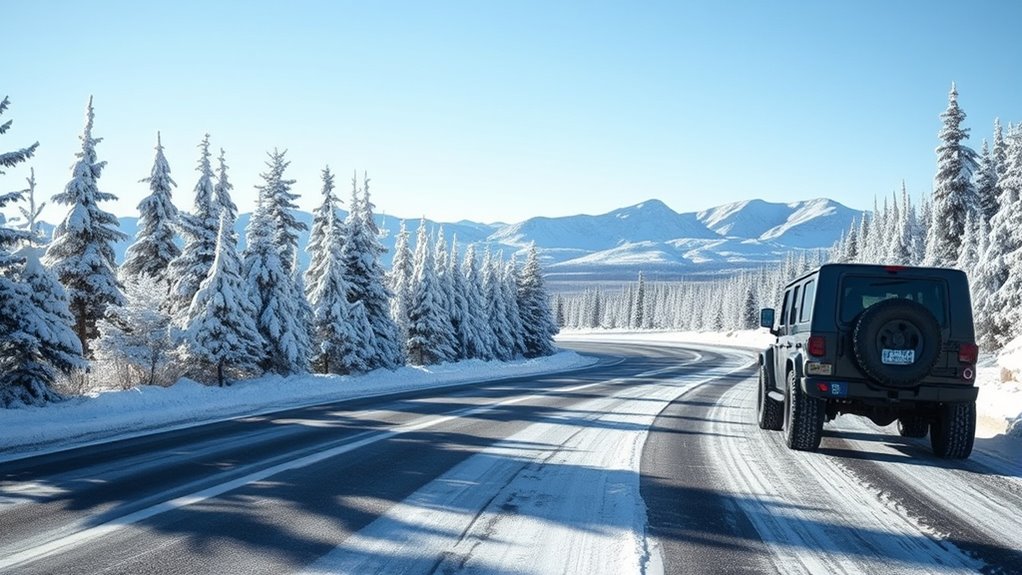Before driving the Alaska Highway in winter, check your vehicle’s insulation, antifreeze levels, and tires, and pack emergency supplies like blankets, food, and a flashlight. Stay informed about road conditions and weather alerts, and use traction devices such as snow chains. Drive slowly, smoothly, and with headlights on, keeping safe distances from other vehicles. Be alert for wildlife and hazards, and plan your stops carefully. If you keep these tips in mind, you’ll be ready for a safe journey.
Key Takeaways
- Prepare your vehicle with winter tires, proper antifreeze levels, and emergency supplies for cold conditions.
- Stay informed about road closures, weather updates, and plan alternative routes accordingly.
- Carry essential safety gear, including blankets, food, water, and communication devices, for emergencies.
- Drive slowly, smoothly, and maintain a safe following distance to prevent skidding on icy roads.
- Use GPS and maps, equip snow chains, and adjust travel plans based on current weather and road conditions.
Prepare Your Vehicle for Cold Weather Conditions
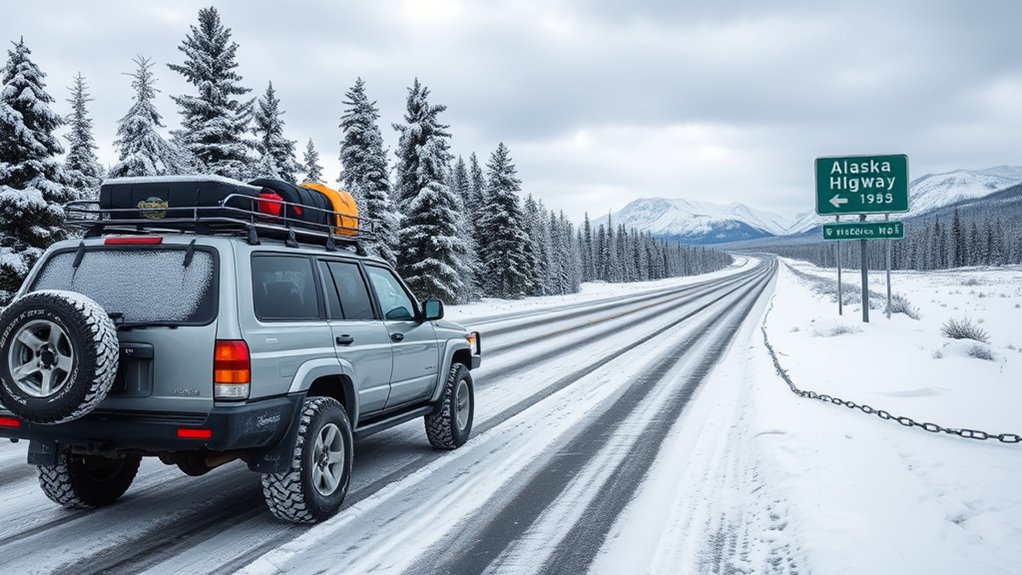
Before hitting the road in winter, you need to make sure your vehicle is ready for cold weather conditions. Start by checking your vehicle insulation—guarantee hoses and wiring are in good shape to prevent freezing. Proper vehicle insulation keeps the engine and other crucial parts protected from extreme cold, reducing the risk of damage. Next, verify your antifreeze levels; they should be topped off and properly mixed to prevent freezing and corrosion. Using the right antifreeze mixture ensures your engine stays protected even in freezing temperatures. Additionally, inspect your radiator and cooling system for leaks or damage. Keeping your vehicle well-insulated and maintaining correct antifreeze levels are essential steps to avoid breakdowns and ensure reliable performance on Alaska’s winter roads.
Check Road and Weather Conditions Before You Depart
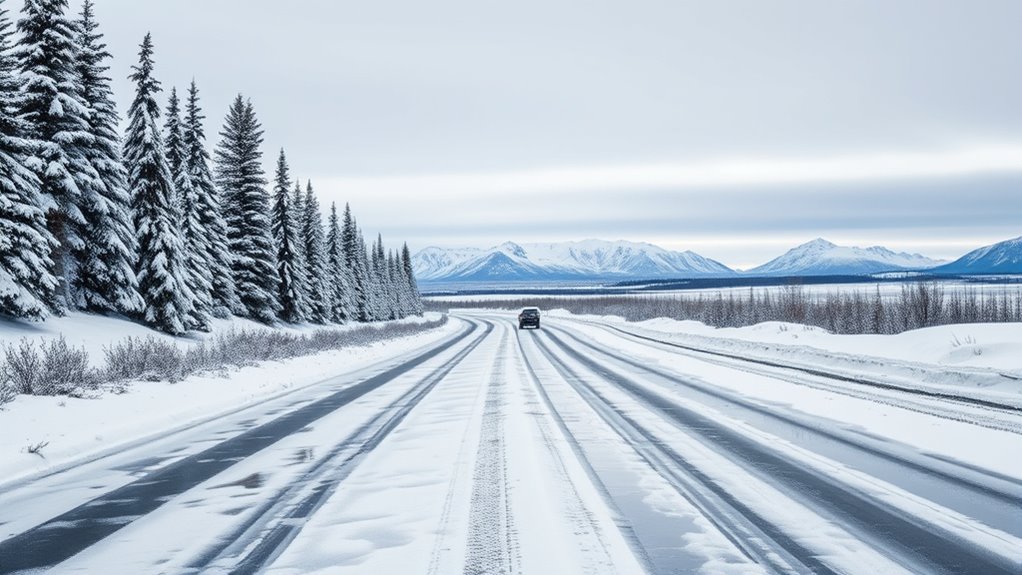
Checking road and weather conditions is an essential step before heading out on Alaska’s winter highways. Stay informed to guarantee your safety and avoid surprises. Start by reviewing current road closure updates, which can change rapidly due to snow, ice, or accidents. Next, monitor weather forecast alerts to anticipate storms or low visibility. To stay well-prepared, follow these steps:
- Visit official transportation websites for real-time road closure updates.
- Check weather forecast alerts from trusted sources like the National Weather Service.
- Listen to local radio or traffic reports before departure.
- Use GPS apps that provide live traffic and weather information.
- Understanding contrast ratio can help you better interpret visual cues from your vehicle’s instruments and road signs in low-light conditions.
Pack Emergency Supplies and Safety Gear
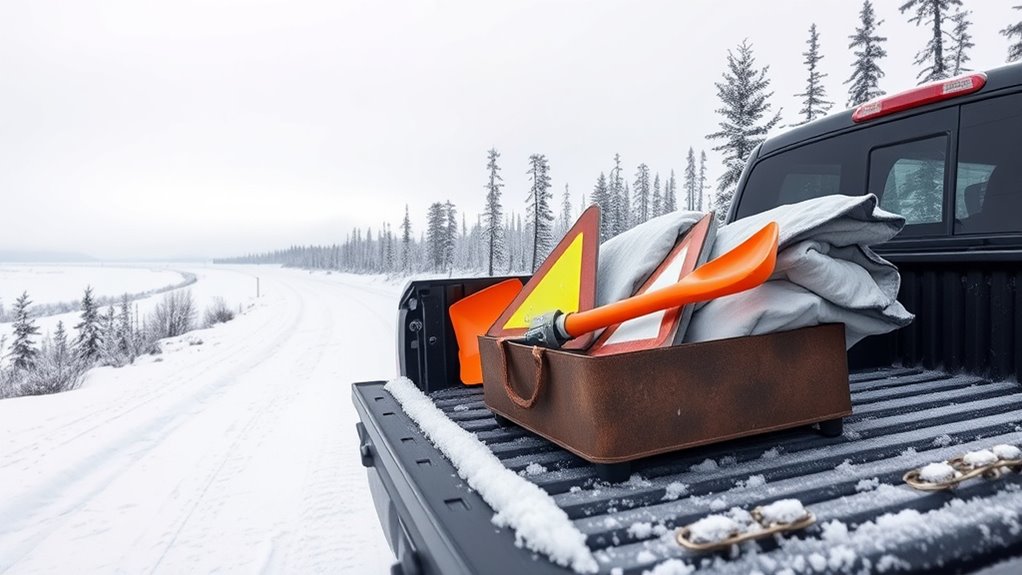
Make sure you pack an emergency kit with essentials like food, water, and first aid supplies. Include warm clothing and blankets to stay comfortable if you get stranded. Don’t forget navigation tools and a charged communication device to help you stay on track and call for help if needed. Carrying grocery savings strategies can also be helpful in planning your trips and ensuring you have everything you need. Additionally, understanding creative storytelling for branding can make your journey more engaging and memorable if you share your experiences safely. Remember, awareness of angel numbers can provide spiritual reassurance during challenging drives, helping you stay calm and confident on winter roads. Incorporating industry trends into your preparation can also boost your confidence and adaptability in unexpected situations. Being aware of local weather patterns can help you anticipate and prepare for sudden snowstorms or icy conditions.
Emergency Kit Essentials
Having a well-stocked emergency kit is essential for winter driving on the Alaska Highway, where conditions can change rapidly. A good kit prepares you for winter survival and roadside emergencies, increasing safety. Make certain your kit includes:
- Warm clothing, hats, and gloves to stay warm if you’re stranded.
- Non-perishable food and water to maintain energy and hydration.
- First aid supplies for injuries or health issues.
- Emergency tools like a flashlight, batteries, a multi-tool, and jumper cables.
- Remember that maintaining your vehicle and understanding couples’ communication strategies can also be vital during stressful situations, ensuring you stay calm and effective until help arrives. Additionally, familiarity with survivalism techniques can improve your preparedness for unexpected scenarios in remote areas. Knowing how to manage stress effectively can help you stay focused and make better decisions during emergencies. Incorporating emergency communication methods, such as a satellite phone or emergency beacon, can also be crucial when traveling through remote regions with limited cell service. Being aware of vehicle maintenance essentials can prevent breakdowns and ensure your vehicle remains reliable in harsh winter conditions.
These essentials help you handle unexpected situations, whether it’s a vehicle breakdown or severe weather. Staying prepared with the right supplies can make all the difference when facing winter roadside emergencies, keeping you safe until help arrives.
Warm Clothing and Blankets
Since winter conditions on the Alaska Highway can change suddenly, packing warm clothing and blankets is essential for your safety. Make sure to bring thermal layers, including thermal underwear and insulated outerwear, to stay warm in freezing temperatures. These layers trap body heat and provide vital insulation. Additionally, pack insulated blankets that can keep you warm if you’re stranded or stuck in your vehicle. Having extra blankets in your emergency kit helps maintain your body temperature during unexpected delays or breakdowns. Don’t forget to wear a warm hat and gloves, as a significant amount of heat escapes from your head and hands. Properly prepared clothing and blankets can make a critical difference in keeping you safe in extreme winter conditions on the highway. Using quality outdoor gear can further enhance your protection against harsh weather. Being aware of best safety practices when driving in winter conditions can also help prevent dangerous situations and ensure a safer journey. Additionally, understanding the importance of proper vehicle maintenance can help avoid breakdowns in remote areas where assistance may be limited. Recognizing the genetic traits of your vehicle’s performance can help you better prepare for unpredictable winter road conditions.
Navigation and Communication Tools
In addition to dressed for warmth, ensuring you have reliable navigation and communication tools can prevent you from getting lost or stranded in remote winter conditions. Carry a GPS navigation device to stay on course, especially if trails are unmarked or visibility drops. A satellite communication device is essential for emergencies where cell service fails. To stay prepared, make sure you have:
- A fully charged GPS navigation system
- A satellite communication device for rescue alerts
- A portable power bank or extra batteries
- Printed maps as a backup in case electronic devices fail
These tools help you maintain your route and contact help if needed. Proper navigation and communication gear are crucial for safe winter driving on the Alaska Highway.
Drive With Appropriate Tires and Traction Devices
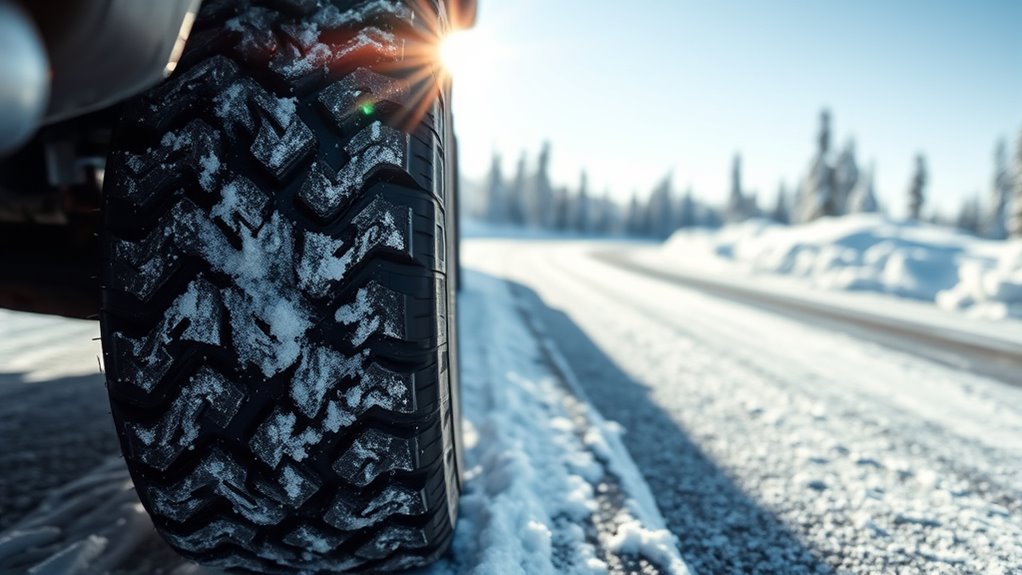
Equipping your vehicle with the right tires and traction devices is essential for safe winter driving on the Alaska Highway. Snow chains are a reliable option to improve grip on icy or snow-covered roads, especially in challenging conditions. Before installing them, check your tire pressure to guarantee optimal traction and handling. Proper tire pressure helps your tires maintain maximum contact with the road, reducing the risk of slipping. Consider using winter tires designed for cold temperatures, as they offer better traction and control. Keep a set of snow chains handy, and practice installing them before your trip. Ensuring your tires are suitable for winter conditions markedly enhances safety, giving you better control and confidence while steering icy stretches on the highway. Proper tire maintenance is crucial for overall vehicle safety during winter travel. Additionally, staying informed about AI cybersecurity can help protect your vehicle’s navigation and communication systems from emerging digital threats. Regularly inspecting your vehicle’s tire condition also contributes to safer winter driving, and being aware of road condition updates can help you plan safer routes.
Adjust Your Driving Style for Icy and Snowy Roads
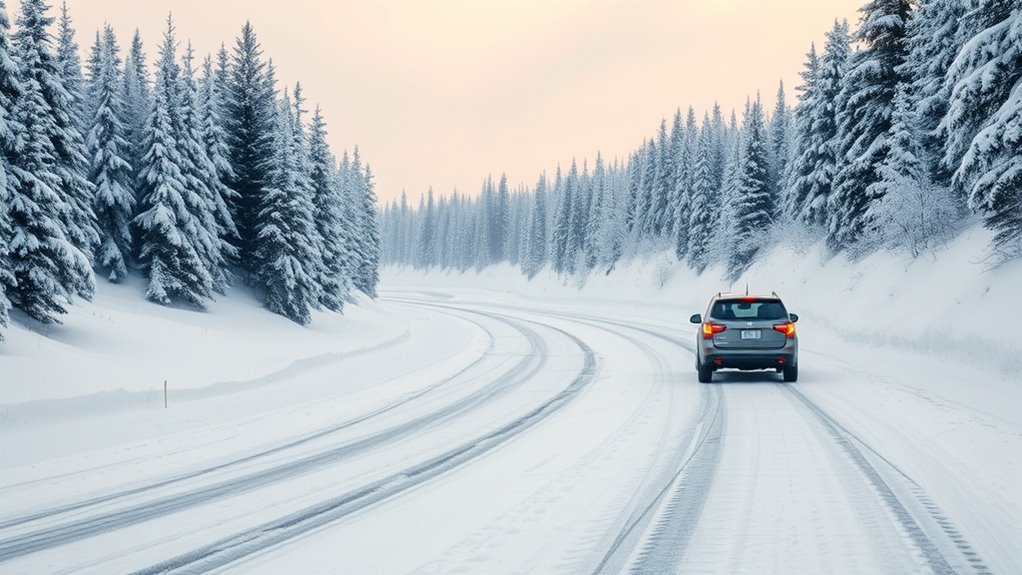
When driving on icy and snowy roads, it is crucial to adjust your driving style to maintain control and stay safe. Your driving techniques should focus on smooth, deliberate movements to prevent skidding. To improve road etiquette and safety, remember these tips:
Drive smoothly on icy roads to stay safe and maintain control.
- Accelerate gently to avoid wheel spin.
- Brake slowly and gradually, never slam the brakes.
- Steer smoothly to maintain traction and control.
- Anticipate turns and curves well in advance, reducing your speed early.
- Applying consistent messaging in your driving approach helps reinforce safe behaviors during winter conditions. Additionally, understanding the importance of proper equipment maintenance can inspire innovative solutions for vehicle safety technology and road management systems. Ensuring your vehicle’s coolers and freezers are well-maintained can prevent unexpected breakdowns in cold conditions, thereby enhancing safety. Regular vehicle inspections and maintenance contribute to better handling on icy roads and can reduce the risk of accidents.
Maintain Safe Distances and Reduce Speed
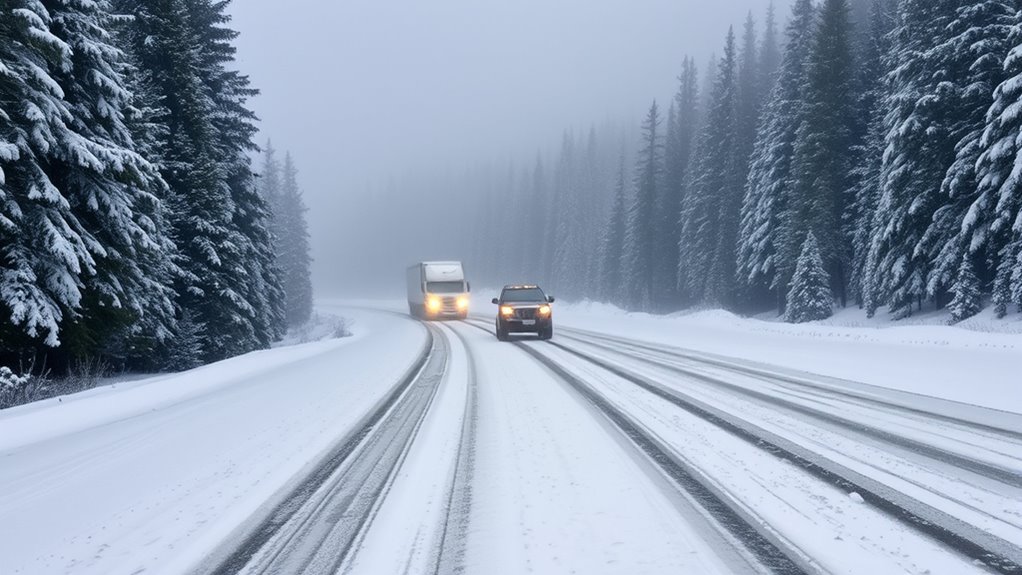
To stay safe on winter roads, keep a safe following distance so you have time to react. Dial back your speed when road conditions worsen, especially on icy or snowy surfaces. Be extra cautious at night, when limited visibility makes it harder to judge distances and spot hazards.
Keep Safe Following Distance
Maintaining a safe following distance is crucial on icy and snowy roads, where stopping distances can increase unexpectedly. To guarantee safe braking, give yourself extra space between your vehicle and the one ahead. This helps you react in time and prevents collisions. Remember these key points:
- Increase following distance to at least 8-10 seconds behind the vehicle in front.
- Adjust your distance based on road conditions and visibility.
- Avoid tailgating, especially in poor traction conditions.
- Stay alert to sudden stops or slowdowns, maintaining your space at all times.
Adjust Speed for Conditions
Adjusting your speed to match road conditions is essential for safe driving on icy and snowy Alaska highways. Proper speed control helps you stay in control and prevents accidents in unpredictable winter weather. When the roads are slick or visibility is poor, reduce your speed well below the posted limit. Slower speeds give you more time to react to sudden hazards like black ice or drifting snow. Always stay alert and adapt your driving to current conditions, not just the speed limit. Maintaining a safe distance from other vehicles is equally important, as stopping distances increase on icy roads. Remember, driving too fast for conditions increases the risk of skidding or losing control. Adjust your speed accordingly to stay safe and ensure a smooth journey through winter’s challenges.
Use Caution at Night
When driving at night on Alaska highways, you need to be extra cautious because limited visibility makes it harder to see hazards. To stay safe, maintain safe distances from other vehicles and reduce your speed. Night visibility is poor, so give yourself more time to react. Also, prioritize fatigue management; tired drivers have slower reflexes. Keep these tips in mind:
- Increase following distances to account for reduced visibility.
- Slow down to give yourself more reaction time.
- Take regular breaks to stay alert and manage fatigue.
- Use high beams wisely, switching to low beams when approaching or overtaking other vehicles.
Use Headlights and Clear Windows for Visibility

Since winter conditions can reduce visibility on the Alaska Highway, it is vital to turn on your headlights even during the day. Headlights improve your visibility to others and enhance your headlights visibility, making it easier to see icy patches or obstacles. Always make sure your windows are clear before driving; foggy or snow-covered windows hinder your ability to see clearly. Use your defroster and windshield wipers to keep your windows free of ice and snow, preventing dangerous blind spots. Proper window clearing is essential for safe driving, especially in low light or snowy conditions. Remember, a clear view through your windows and well-illuminated road ahead help you react quickly to changing conditions, reducing the risk of accidents.
Be Aware of Wildlife and Remote Road Hazards
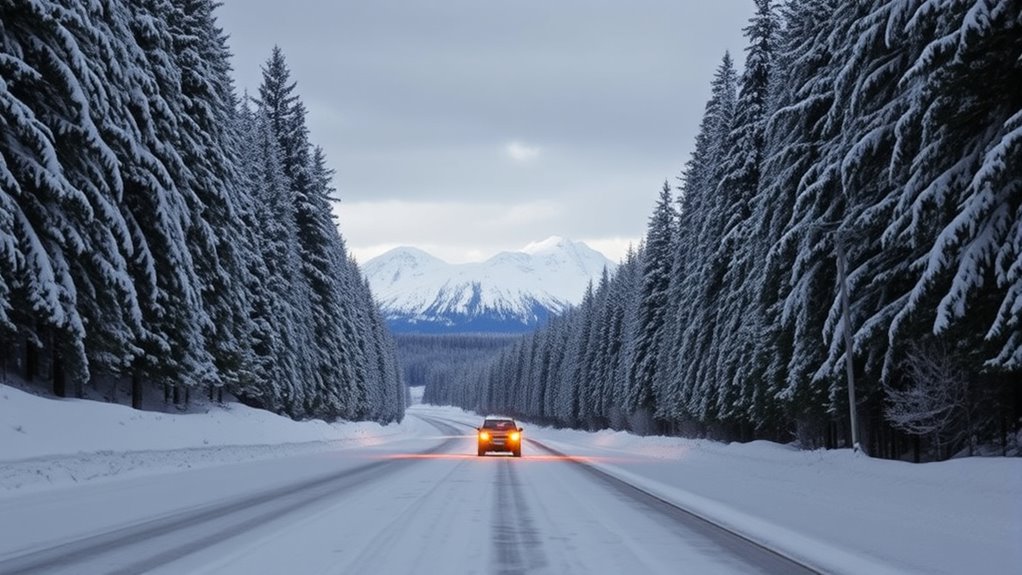
Wildlife and remote road hazards can appear suddenly on the Alaska Highway, especially during winter when animals are more active and visibility is limited. Stay alert for wildlife crossings, as animals like moose or elk may dart into your path unexpectedly. To stay safe, keep these tips in mind:
- Reduce speed in areas known for wildlife activity.
- Watch for animal crossing signs and slow down accordingly.
- Use high beams when appropriate to spot animals early.
- Be prepared for remote road hazards like icy patches, snowdrifts, or fallen branches.
Remaining vigilant helps you spot potential dangers early, giving you time to react. Remember, wildlife crossings often happen without warning, so staying attentive is your best defense against surprises on the road.
Plan Your Stops and Know Emergency Exit Points
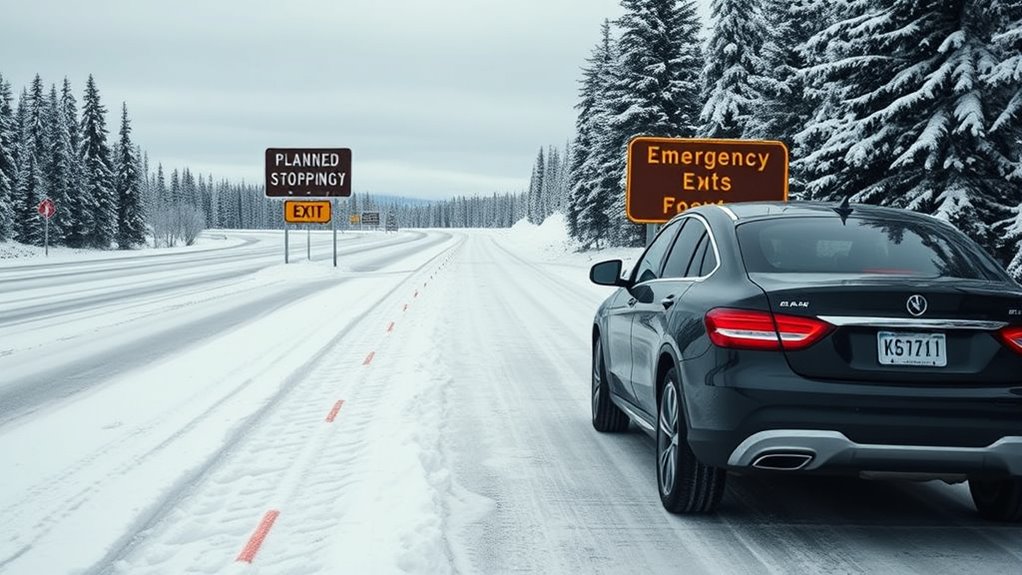
Planning your stops along the Alaska Highway makes sure you stay safe and prepared for unexpected situations. Rest stop planning helps you avoid fatigue and ensures you have access to amenities when needed. Before your trip, identify safe places to pull over, especially in remote areas, and mark emergency exit points along the route. Knowing where these exits are can be lifesaving if you encounter vehicle trouble or severe weather. Keep a map or GPS handy to navigate to these points quickly. Regular stops also give you a chance to check your vehicle’s condition and stay alert. Staying aware of emergency exit locations and planning your rest stops in advance keeps you prepared, reduces stress, and helps you respond swiftly if an emergency arises.
Stay Informed and Communicate During Your Journey
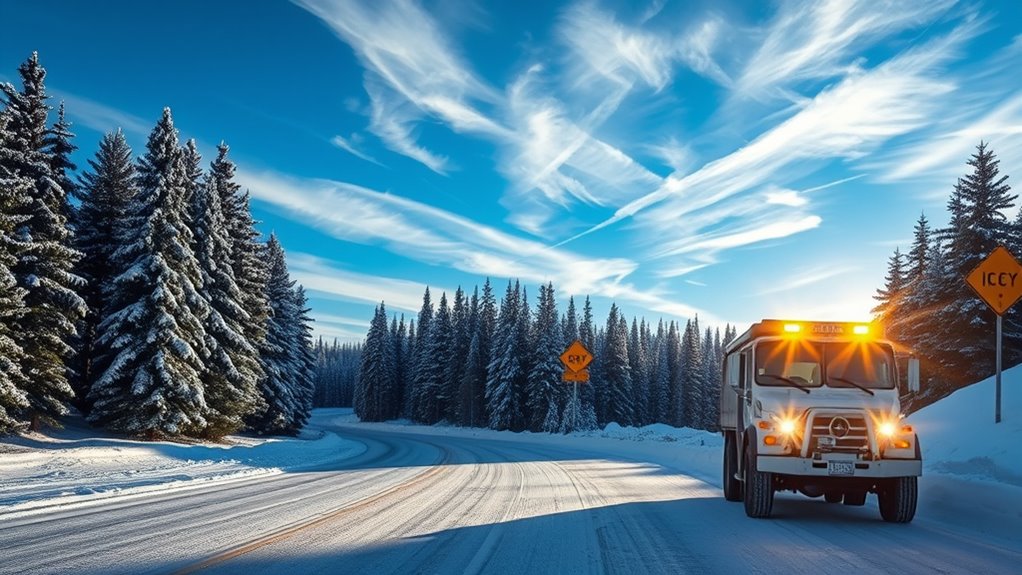
Staying informed and maintaining communication throughout your journey is essential for safety on the Alaska Highway. Using radio communication helps you stay connected, especially in remote areas with limited cell service. Regularly check travel alerts from authorities to receive updates on road conditions and closures. To stay ahead, consider these tips:
- Carry a NOAA weather radio for real-time updates.
- Tune into local radio stations for current travel alerts.
- Share your itinerary with a trusted contact before departing.
- Keep a charged backup power source for your communication devices.
Frequently Asked Questions
What Are the Best Times of Day for Safe Winter Driving in Alaska?
You should aim for daylight driving when traveling in Alaska during winter, as it offers better visibility and safer conditions. Avoid nighttime hazards like icy roads, reduced sight distance, and colder temperatures that can make driving more dangerous. Planning your trips during the day helps you see potential obstacles and respond promptly. Keep track of sunrise and sunset times to maximize daylight hours, ensuring a safer, more comfortable journey.
How Can I Prevent My Vehicle From Freezing Overnight?
Picture your vehicle nestled in a frosty landscape, waiting for dawn. To prevent freezing overnight, verify your vehicle insulation is robust—use a windshield cover and seal doors tightly. Regular antifreeze maintenance keeps the engine fluid flowing smoothly. Park in a sheltered spot or under a carport if possible, and consider a engine block heater. These steps create a barrier against the cold, helping your vehicle start easily each morning.
Are There Specific Tips for Driving Through Snowdrifts or Deep Snow?
When maneuvering snowdrifts or driving through deep snow, you should reduce your speed and stay alert for hidden obstacles. Use gentle, steady movements to maintain control, avoiding sharp turns or sudden braking. Engage your 4WD if available for better traction. Keep a safe distance from other vehicles, and if you get stuck, avoid spinning your wheels — instead, try rocking the vehicle forward and back carefully to free it.
What Should I Do if I Get Stranded in Extreme Cold?
If you get stranded in extreme cold, stay calm and prioritize safety. Use your emergency supplies like warm clothing, blankets, and non-perishable food to stay warm. Seek shelter options nearby, such as a vehicle or a nearby building, to protect yourself from the elements. Keep moving gently if possible, and signal for help using your phone or flares. Staying prepared and calm is key to surviving extreme cold conditions.
How Can I Identify and Avoid Hidden Ice Patches on the Road?
Ever wondered how to spot hidden ice patches on the road? You can’t always see them, but paying attention to road surface conditions helps. Look for glossy or black ice, especially in shaded areas or on bridges. Reduce your speed and make sure your vehicle has good tire traction. Stay alert, avoid sudden moves, and trust your senses—these are your best tools for staying safe on icy roads.
Conclusion
By following these tips, you’ll navigate Alaska’s winter roads like a seasoned explorer, turning icy challenges into manageable adventures. Prepare your vehicle, stay alert, and keep communication open—your safety is the compass guiding you through this snowy wilderness. Remember, with the right planning and caution, you’ll not only survive the cold but thrive in it, making your journey as smooth as a winter’s glide across fresh snow.
